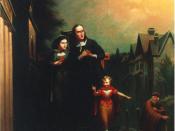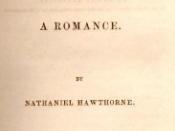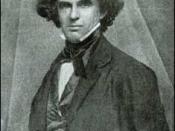Chapter sixteen of The Scarlet Letter offers wonderful symbolism as it finds parallels between the brook and Pearl. Furthermore, the image provides specific areas of similitude. Pearl can be a somewhat complex character, but that character is further explained through this imagery. PearlÃÂs character is understandable through Nathaniel HawthorneÃÂs metaphors of her fixation with one subject, enigmatic birth, and feelings of repression in his novel The Scarlet Letter. HawthorneÃÂs beautiful use of allegory manufactures a development of understanding on PearlÃÂs character.
The eternally unchanging mannerisms of the brook illustrate PearlÃÂs fascination with one topic. Pearl cannot draw her attention away from one issue for very long. In her case, she is obsessed with HesterÃÂs scarlet letter that she must wear. PearlÃÂs preoccupation with this burning symbol is well-explained in the chapter. ÃÂ. . . [T]he brook, in the course of its little lifetime among the forest trees, had gone through so solemn an experience that it could not help talking about it and seemed to have nothing else to say.ÃÂ
HesterÃÂs scarlet letter ÃÂAÃÂ gave birth to Pearl in many ways. Instead of playing with innocent Puritan children her own age, Pearl often finds entertainment for herself through mischievous, and often naughty, behavior. One example is the way she prods in other peopleÃÂs lives, most notably her motherÃÂs. It is only natural that the symbol that shaped her identity should be the point of her fascination. This is demonstrated with the brookÃÂs actions. Its constant babble of moving water is the speech of the same subject, day after day. ÃÂBut the little stream would not be comforted, and still kept telling its unintelligible secret of some very mournful mystery that had happened . . .within the verge of the dismal forest,ÃÂ Hawthorne writes. The brook is unwilling to give up its interest in the topic in the same fashion as PearlÃÂs undeterred quest to find the truth.
PearlÃÂs cryptic birth is represented through the brookÃÂs undiscovered origin. This chapter notes that it is difficult to locate the beginning. As with PearlÃÂs unexplained birth, one cannot easily determine the start. Only those who were involved know the father of Pearl. The rest of the town is left baffled. However, after a while nobody is interested enough to find the truth behind the birth. Pearl has become a part of society that offers a unique twist, but not a significant contribution. Pearl and the brook share a mysterious origin, but both are simply accepted parts of nature. A few authoritative figures may frown upon such a mystery, but the rest of the world has simply forgotten.
Pearl is crushed by oppressive authority, which can be seen in the vegetation around the brook. In chapter sixteen, Hawthorne describes numerous trees and underbrush that surround the defenseless stream, hanging over it and watching it closely. This is directly related to the harsh Puritan authority Pearl is crushed beneath. Instead of being a vast, uncontrollable ocean, the brook is forced to its smallest state possible, and even then it is restricted. Pearl cannot roam free with other children, as she is Puritan, and her family has committed a sin. Her mother, fearing that she may commit unforgivable sins, is forced to contain her in a minute cottage away from society. Pearl cannot prance around with other families, and she is almost going mad from frustration. This also mostly accounts for PearlÃÂs rebellious behavior. If she were allowed privileges of mixing with other families, she would not have to fight back so forcefully. In fact, Pearl might actually be a polite, courteous little girl. Hawthorne notices this as he writes the following: ÃÂLetting the eyes follow along the course of the stream, they would catch the reflected light from [the brookÃÂs] water at some short distance within the forest, but soon lost all traces of it amid the bewilderment of tree-trunks and underbrush . . . .ÃÂ Like the brookÃÂs pressure from the trees and underbrush, Pearl is contained to be dark and unsatisfied under the Puritan authority.
Hawthorne draws comparisons between the brook and Pearl with his metaphors for PearlÃÂs fascination on one subject, a mysterious source of origin, and the Puritan, oppressive influences in The Scarlet Letter. The well-written imagery in chapter sixteen offers new light on PearlÃÂs dim character. While Pearl was a difficult to understand before, the similarity between Pearl and the brook has cleared up what was once an ambiguity.





